Charging your iPhone with a laptop is a convenient option when wall outlets aren’t available. Whether you’re traveling, working remotely, or simply prefer using your computer as a power source, understanding how iPhone charging with laptop works can help you maximize efficiency and protect your devices. This comprehensive guide covers everything from connection methods to troubleshooting tips for both USB-C and Lightning iPhone models.
The Basics of iPhone Charging with Laptop
When you connect your iPhone to a laptop using a USB cable, your phone draws power from the computer’s battery or power supply. This process is straightforward but comes with several considerations that affect charging speed and efficiency.
How Laptop Charging Works
Your laptop’s USB ports provide power to connected devices through the USB standard. Most laptops feature either USB-A ports (the traditional rectangular shape) or the newer USB-C ports (the smaller, reversible connector). The type of port affects how quickly your iPhone charges.
USB-A Ports
- Standard on older laptops
- Typically deliver 0.5A to 0.9A of power
- Slower charging speeds
- Require Lightning to USB-A cable for iPhones
USB-C Ports
- Common on newer laptops
- Can deliver up to 3A of power
- Faster charging speeds
- Direct connection for iPhone 15 and newer
To charge your iPhone with a laptop, simply connect one end of the appropriate cable to your phone and the other to your computer’s USB port. Your iPhone should begin charging immediately, displaying the charging icon on its screen.
For optimal charging performance, use the original cable that came with your iPhone or a certified third-party alternative. Low-quality cables may deliver inconsistent power or damage your devices.
Looking for more detailed information about USB-C connectors and compatibility? Check Apple’s official guide on USB-C connections to learn about the latest standards and supported devices.
USB-C iPhone Charging: Faster or Slower?

With Apple’s transition to USB-C starting with the iPhone 15 series, many users wonder how this affects charging performance when using a laptop as a power source. The answer depends on several factors including your laptop’s USB capabilities and the specific iPhone model you own.
USB-C Charging Performance
| Connection Type | Power Output | Charging Speed | Compatible With |
| USB-A 2.0 | 2.5W (0.5A/5V) | Slow | All iPhones (with adapter) |
| USB-A 3.0 | 4.5W (0.9A/5V) | Moderate | All iPhones (with adapter) |
| USB-C (Standard) | 15W (3A/5V) | Fast | iPhone 15+ (direct), Others (with adapter) |
| USB-C (PD) | Up to 20W | Very Fast | iPhone 15+ (direct), Others (with adapter) |
USB-C connections generally provide faster charging than older USB-A ports, but your laptop must support USB Power Delivery (PD) to achieve the highest charging speeds. Many modern laptops, especially MacBooks and high-end Windows laptops, include this capability.
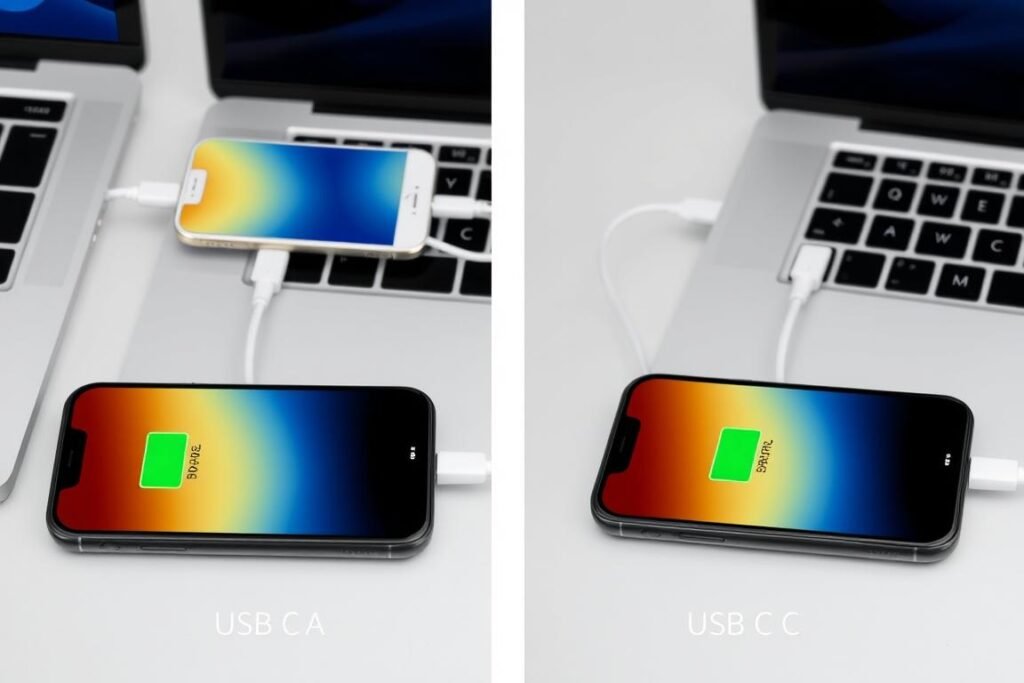
Benefits of USB-C iPhone Charging
- Faster charging speeds with compatible laptops
- Reversible connector makes connection easier
- Same cable works for multiple devices (MacBooks, iPads, Android devices)
- Support for data transfer while charging
- Future-proof standard adopted by most electronics
USB-C is a universally accepted standard that enables charging, syncing data, and playing audio and video. iPhone 15 and later models have a USB-C connector, which allows you to charge and connect to a variety of devices.
Want to learn more about the technical specifications of USB-C charging? Visit the USB Implementers Forum for detailed information about USB Power Delivery standards and compatibility.
Is Charging Your iPhone via Laptop Safe?
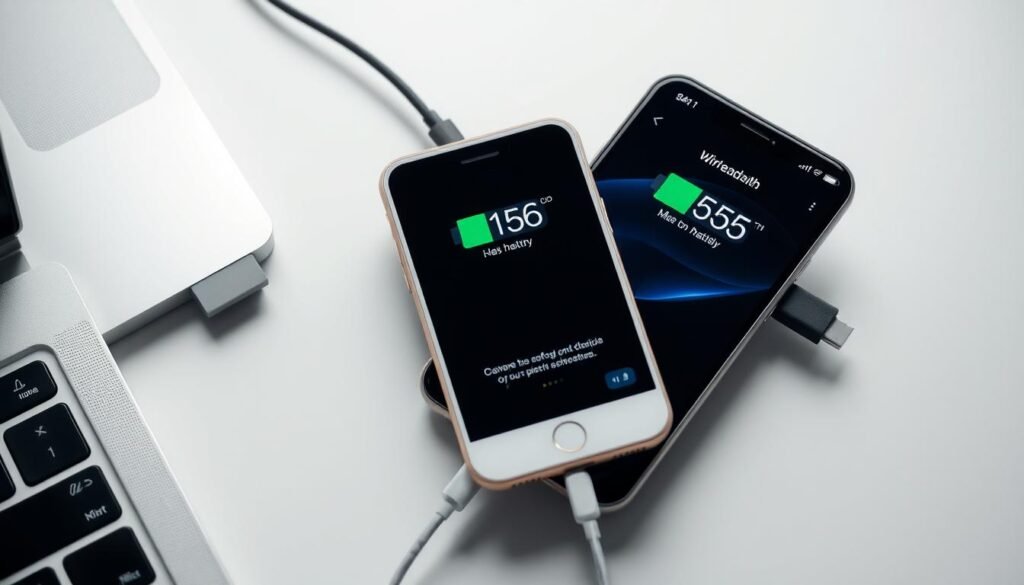
Many iPhone users worry about potential battery damage when charging through a laptop. The good news is that charging your iPhone with a laptop is generally safe, as both devices have built-in power management systems that prevent overcharging and regulate power flow.
Advantages
- Built-in power regulation prevents damage
- Slower charging can be better for battery longevity
- Convenient when wall outlets aren’t available
- Allows simultaneous data transfer and charging
Disadvantages
- Slower charging compared to wall adapters
- Drains laptop battery quickly
- May not charge if laptop is in sleep mode
- Some ports provide insufficient power
Common Safety Concerns
Will charging from a laptop damage my iPhone battery?
No, charging your iPhone from a laptop won’t damage the battery. Modern iPhones have sophisticated power management systems that regulate incoming power regardless of the source. In fact, the lower power output from laptop USB ports may actually be gentler on your battery compared to fast chargers.
Is it safe to leave my iPhone charging overnight via laptop?
Yes, it’s safe to leave your iPhone charging overnight via laptop. Both devices will stop the charging process once the battery is full. However, keeping your laptop plugged in and running all night for this purpose isn’t energy-efficient and may generate unnecessary heat.
Can using third-party cables damage my devices?
Low-quality third-party cables may pose risks including inconsistent charging, overheating, or even damage to your devices. Always use Apple-certified (MFi) cables or reputable third-party alternatives to ensure safety and optimal performance.
If you notice your iPhone or laptop becoming unusually hot during charging, disconnect immediately. Excessive heat can indicate a problem with your cable, port, or device that should be addressed to prevent damage.
Concerned about maintaining your iPhone’s battery health? Read Apple’s battery health guide for official recommendations on charging practices and battery maintenance.
Computer Charging Tips for iPhone Users
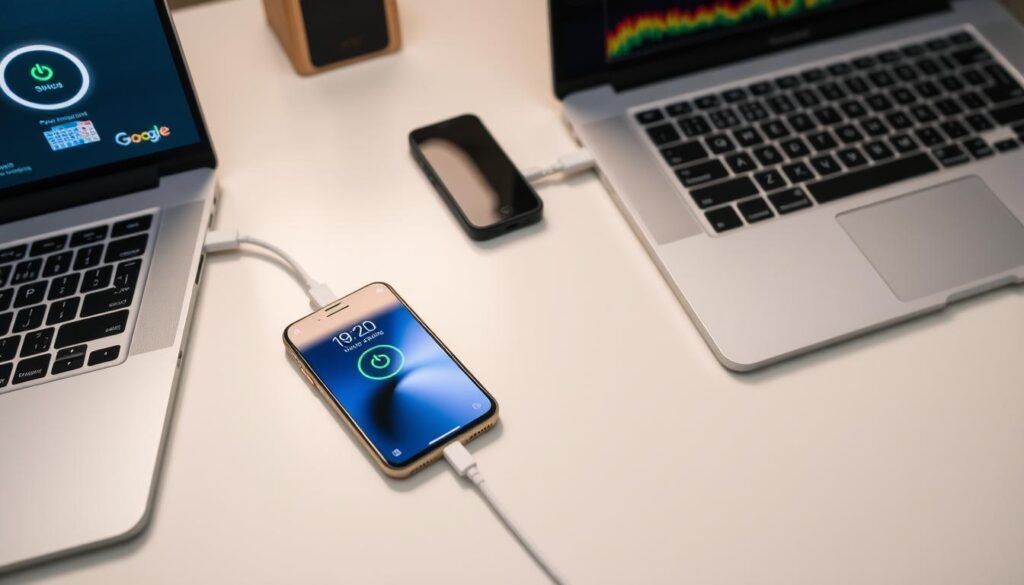
To get the most out of charging your iPhone with a laptop, follow these practical tips that maximize efficiency and protect both devices.
Optimizing Charging Speed
- Close unnecessary apps on your laptop
- Use high-power USB ports (usually colored blue)
- Ensure laptop is plugged in if possible
- Check cable for damage or debris
- Restart devices if they haven’t been restarted recently
Before Connecting
- Put iPhone in Airplane Mode
- Close background apps on iPhone
- Keep screen brightness low or screen off
- Avoid using iPhone while charging
- Keep devices at moderate temperature
While Charging
- Try different USB ports
- Test with different cables
- Check for port debris or damage
- Update device software
- Reset USB controllers in Device Manager
Troubleshooting
MacBook-Specific Charging Tips
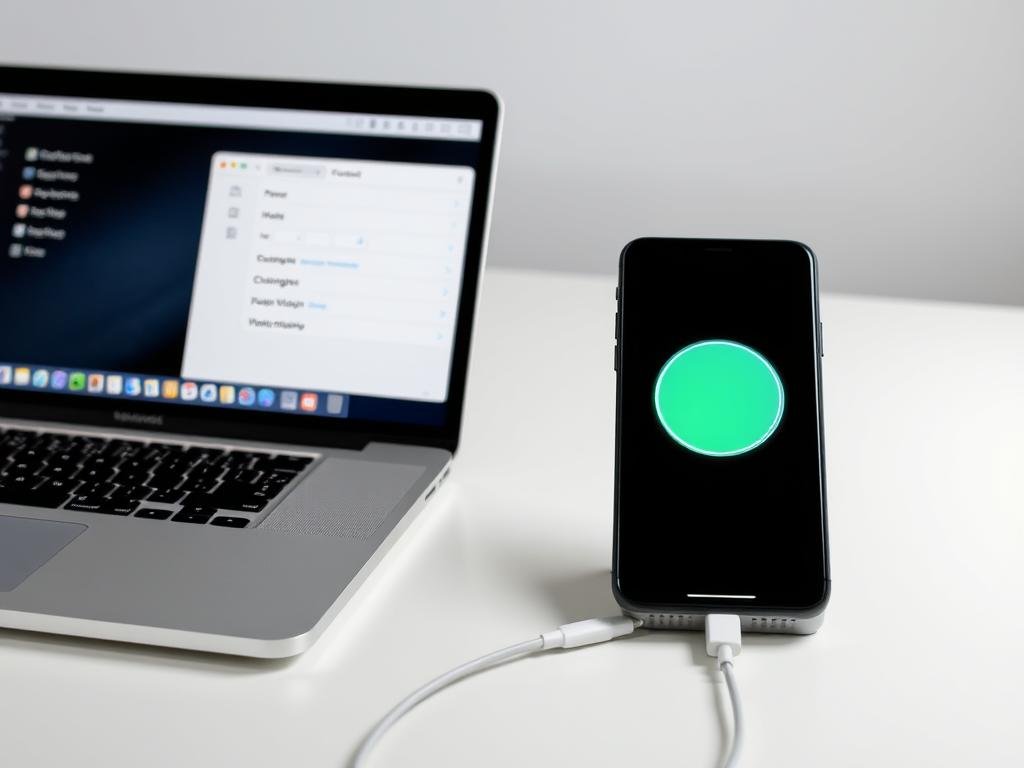
If you’re using a MacBook to charge your iPhone, these additional tips can help optimize the process:
- Open the MacBook lid and power it on before connecting your iPhone
- Connect your iPhone to the USB port
- After charging begins, you can close the lid to put the MacBook to sleep
- The iPhone will continue charging even with the MacBook asleep
- For faster charging, keep the MacBook plugged into power
A MacBook Air battery can fully charge an iPhone approximately 3-4 times before being depleted. This makes it an excellent emergency power bank when traveling.
Troubleshooting Common Issues
iPhone Not Charging or Charging Slowly
If your iPhone isn’t charging properly when connected to your laptop, try these solutions:
- Check if your laptop is in sleep or hibernation mode
- Try a different USB port (preferably USB 3.0 or higher)
- Inspect the cable for damage and replace if necessary
- Clean the charging port on your iPhone with compressed air
- Update your laptop’s USB drivers
- Restart both devices
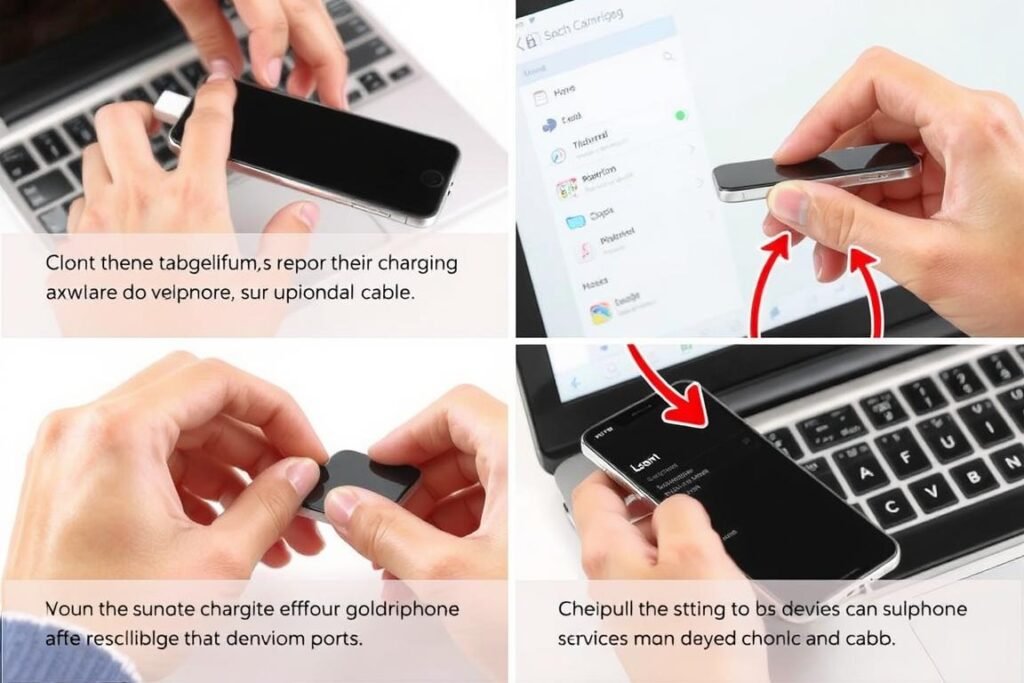
Having persistent issues with your iPhone not being recognized by your computer? Visit Apple’s connection troubleshooting guide for step-by-step solutions to common connectivity problems.
Advanced Charging Scenarios
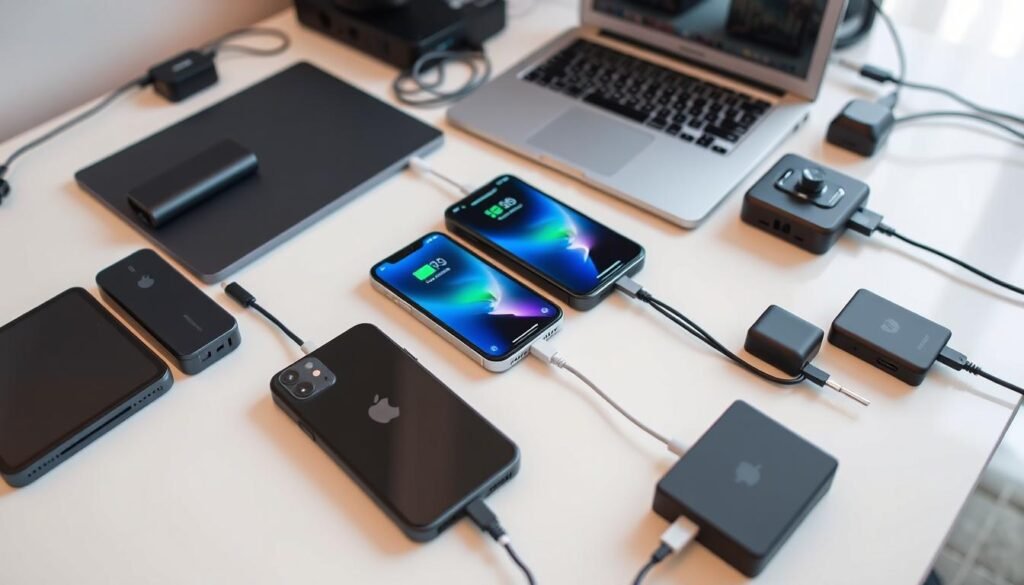
Beyond basic charging, there are several advanced scenarios where charging your iPhone with a laptop can be particularly useful or require special considerations.
Emergency Power Bank
Your laptop can serve as an emergency power bank for your iPhone when traditional charging options aren’t available. This is especially useful during travel, power outages, or outdoor activities.
Laptop Battery Capacity Comparison
Different laptop models offer varying charging capacity for your iPhone:
| Laptop Model | Battery Capacity | iPhone Charges (Approx.) |
| MacBook Air M1/M2 | 49.9 Wh | 3-4 full charges |
| MacBook Pro 14″ | 70 Wh | 5-6 full charges |
| Dell XPS 13 | 52 Wh | 3-4 full charges |
| Lenovo ThinkPad X1 | 57 Wh | 4-5 full charges |
Charging While Transferring Data
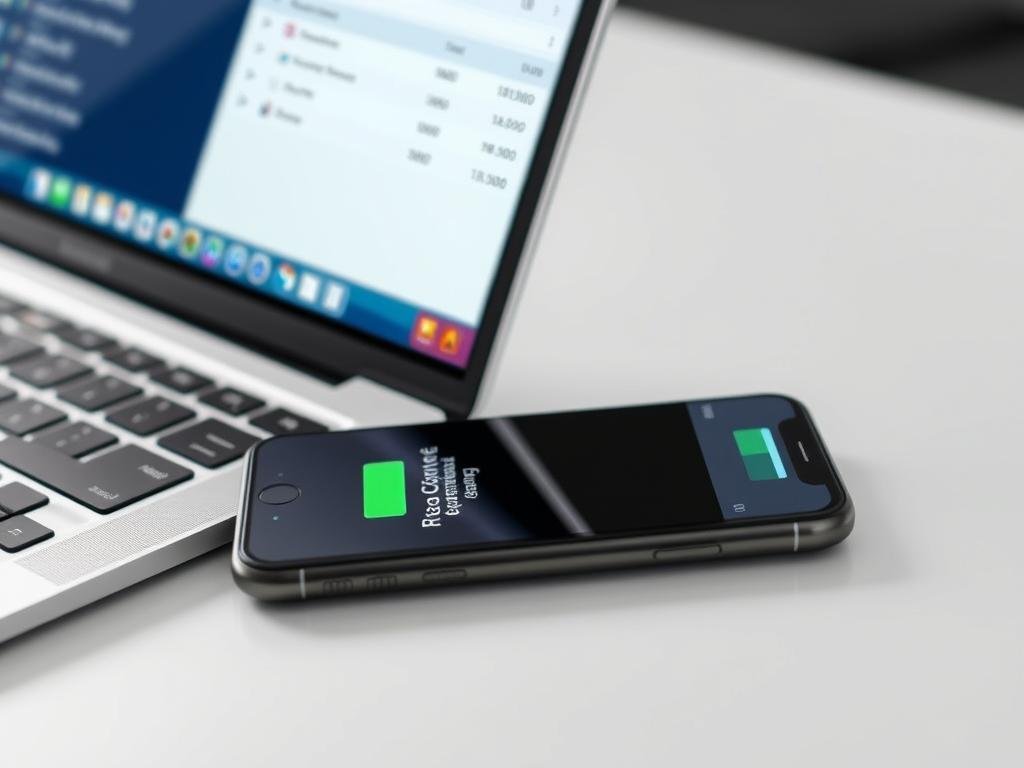
One advantage of charging your iPhone with a laptop is the ability to simultaneously transfer data, backup your device, or update software. This dual functionality makes it efficient for managing your iPhone while keeping it powered.
Data Transfer Tips
- Use high-speed USB 3.0 ports when available
- Keep your iPhone unlocked during initial connection
- Trust the computer when prompted on your iPhone
- Use iTunes or Finder (macOS Catalina and later) for backups
- Consider using AirDrop for quick file transfers while charging
Software Considerations
- Update iTunes or macOS for optimal connectivity
- Install proper drivers on Windows computers
- Keep iPhone iOS updated to latest version
- Disable automatic sync if you only want to charge
- Check Device Manager on Windows for connection issues

Car and Travel Charging
When traveling, particularly in cars without USB ports or with low-power ports, your laptop can be an excellent charging solution for your iPhone.
If you’re using your laptop to charge your iPhone in a car, consider using a car power inverter to keep your laptop charged. This creates a sustainable charging solution for long road trips.
Looking for more travel-friendly charging solutions? Explore portable charging options that can complement laptop charging when you’re on the go.
Final Thoughts on iPhone Charging with Laptop
Charging your iPhone with a laptop offers a convenient alternative to wall adapters, especially in situations where power outlets are limited. While it may not provide the fastest charging speeds, it’s a safe and practical solution that can keep your device powered while also enabling data transfer and management.
Remember that the efficiency of laptop charging depends on several factors including your laptop model, port type, cable quality, and iPhone model. By following the tips and best practices outlined in this guide, you can optimize the charging process and ensure both your iPhone and laptop remain in good condition.
Whether you’re a frequent traveler, a remote worker, or simply looking for charging alternatives, mastering the art of iPhone charging with laptop can be a valuable skill in today’s connected world.
Need More iPhone Charging Solutions?
Discover the full range of charging options and accessories compatible with your iPhone model.